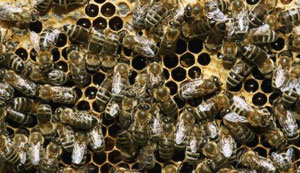
Is goodness natural?
It is hard to imagine that anyone thinks of goodness as a problem, but Charles Darwin did. The little worker bees that sacrificed themselves to protect their hives - the ultimate example of animal goodness - kept Darwin up at night. Given Darwin's ideas about evolution by natural selection were correct (and, of course, they were and are), then this sort of altruism should be extraordinarily rare in nature. If increased reproduction is the ultimate end all and be all of evolution by natural selection, then altruists should disappear - and fast. But they don't disappear, and Darwin was so puzzled by this that he spoke of altruism as a problem that could prove fatal to his whole theory of evolution. Then a solution to this nasty conundrum hit Darwin like a ton of bricks. Worker bees weren't helping just any old bunch of bees; they were protecting their hive. And their hive contained special individuals: blood relatives. Blood relatives are, by definition, very similar to one another. So even though the little worker bees may have been giving up their lives, by doing so they were potentially saving hundreds of blood relatives. In modern parlance, we'd say that the worker bees were helping blood kin, because blood kin are genetically related. By helping your blood relatives, you are indirectly promoting the reproduction of copies of your own genes - copies that just happen to reside inside your kin. Darwin wasn't the only scientist who was fascinated with the question of the evolution of goodness. In fact, his good friend and colleague, Thomas Henry Huxley, was as well. Huxley, in fact, got himself into quite a heated argument over whether blood kinship could or could not explain altruism. Huxley's opponent was Prince Peter Kropotkin, ex-page to the Czar of Russia, naturalist, and arguably the most famous anarchist of the nineteenth century. Huxley argued that all goodness could be traced to blood kinship, while Kropotkin argued that goodness and blood kinship were completely divorced from one another - one had nothing to do with each other. Of course, neither was right, but it would take almost a hundred years before a shy, reserved, and brilliant British biologist named William D. Hamilton would settle all the arguments about blood kinship and altruism by coming up with a simple, but elegant mathematical equation. Instead of asking if blood kinship explains everything or nothing about altruism, Hamilton approached the question differently. He began by defining three terms: the genetic relatedness between individuals (labeled r), the cost of an act of goodness (c), and the benefit that a recipient obtained when someone was nice to him or her (b). Using some beautiful mathematics, in the early 1960's Hamilton discovered that altruism and blood kinship are not linked by an all- or- nothing relationship. Instead, what is now known as "Hamilton's Rule" states that altruism evolves whenever r times b is greater than c. In other words, if enough relatives receive benefits from altruism to outweigh the cost of altruism, then altruism spreads; otherwise, it does not. Phrased in the cold language of natural selection, blood relatives are worth helping in direct proportion to their genetic (blood) relatedness, weighted by how great a benefit they received. Literally thousands of experiments with both nonhumans and humans show the power of Hamilton's Rule. This little equation is evolutionary biology's version of e = mc2. Over and over, we see that an analysis of the costs and benefits of altruism, along with the genetic relatedness of interactants, allows us to predict the presence or absence of altruism. Hamilton's Rule, of course, does not explain all altruism. Another large chunk of goodness falls under the category of "reciprocity." Individuals are sometimes willing to be altruistic to someone now in the expectation that they will, in turn, be helped when they need it. Evolutionary biologists have been almost as interested in this type of altruism, as they have been in kinship-based altruism. Amazingly enough, it was Bill Hamilton, along with the political scientist Robert Axelrod and the evolutionary biologist Robert Trivers, who formalized the models behind the evolution of reciprocity. Following up on work done by Trivers in the early 1970's, in 1981, Axelrod and Hamilton used the mathematics of game theory to predict when so-called "reciprocal altruism" should evolve. Again, scores of empirical studies have followed up the model. Reciprocity can be complex, but an evolutionary perspective has cleared the path to understanding, just the same way it did in the case of blood kinship and altruism. If goodness is a problem, then the answer - or at the least part of the answer - can be found in evolutionary biology. Lee Alan Dugatkin is a Professor of Biology and Distinguished University Scholar in the Biology Department at The University of Louisville. His most recent book is "The Altruism Equation: Seven Scientists Search for the Origins of Goodness" (Princeton University Press, 2006). Copyright: project Syndicate, 2007 |
| || Front
Page | News
| Editorial
| Columns
| Sports
| Plus
| Financial
Times | International
| Mirror
| TV
Times | Funday
Times || |
| |
Copyright
2007 Wijeya
Newspapers Ltd.Colombo. Sri Lanka. |
